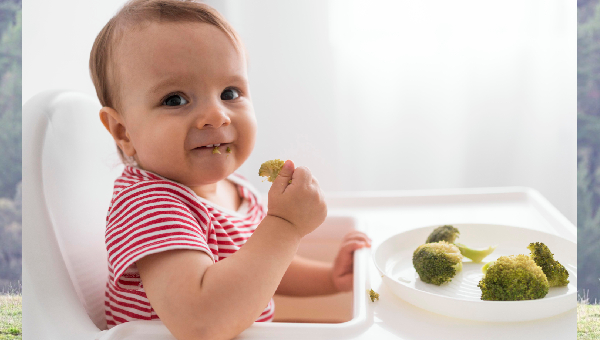Tiny Bites, Mighty Nutrition: Power-Packed Solids for Your Baby
Building Strong Bodies: The Best Solid Foods for Toddler Growth

As your baby enters the age of a toddler, the dietary requirements turn up to an entirely different level. The period is characterized by physical and cognitive maturity, curiosity, and acquisition of permanent dietary patterns. Solid foods are required, not only to provide a source of energy, but also to enable muscle, bone, and brain growth, as well as to support the immune system. Switching to solid food may be a joyous and terrifying milestone as your baby leaves breast milk or formula. Selecting among the most appropriate foods that can make your toddler grow strong and healthy can serve as the premise for the establishment of a positive attitude toward food.
Knowledge of Toddler Consumption
At the ages of 1-3, children of the toddler stage need a combination of macronutrients and micronutrients that will help them grow. These bodies are already developing muscles, bones, and brain connectivity at a rapid pace. Calories ought to be not merely energy-laden, but also nutritious. This implies selecting foods that are high in vitamins, minerals, proteins, healthy fats, and complex carbohydrates as opposed to sugary and overly processed snacks.
Many toddlers needs 1,000 to 1,400 calories per day, either more or less, depending on their energy level. These calories have to be prudently metered out to different food categories, such as fruits and vegetables, cereals, milk, and protein-rich sources of food, to fulfill their growth requirements.
Nutritious Foods Rich in Iron: Body and Brain Nourishment
Iron plays a very significant role in the supply of oxygen in the blood and brain formation. The lack of iron during the toddler stage may cause anemia and delayed development.
- Lentils: Although Lentils are tiny, they are very nutritious as they contain iron, fiber, and protein, which is apt for growing toddlers. Mashed when cooked, they can be readily added to soup or served with rice.
- Egg yolks: Soft-boiled or scrambled eggs are soft, easy to swallow, and rich in iron.
- Fortified cereals: Take infant or toddler cereal, which is fortified with iron, and combine it with milk or yogurt to give it extra nourishment.
- Leafy green spinach: Eaten in disguise, such as in muffins or as an ingredient in sauces, leafy green spinach is pure iron but with no dominant flavors to affect the palate.
- Lean red meat: Minced beef and slow-cooked beef are a concentrated source of heme iron, which is more easily absorbed than iron in the food environment.
- Vitamin C: Vitamin C is beneficial in enhancing iron uptake; hence, take iron-containing foods with the combination of strawberries, tomatoes, or oranges.
Protein Power: The Growth Ingredients
The mixed animal and plant protein sources enhance the health benefits of toddlers.
- Chicken and turkey: The lean meat could be shredded or minced to enable easy chewing and make complete proteins.
- Tofu: Tofu is a protein and calcium-rich, mild and versatile food that may be incorporated in stir-fries or crushed into sauces.
- Cheese: Mild cheeses such as cheddar or mozzarella, cut up into cube-shaped pieces, are delicious as well as a source of protein and calcium.
- Beans: Fats assist in brain development, hormones, and the absorption of nutrients, as long as you choose the healthy ones. Turn into small bites or mold into soft small patties, as this makes it easy to eat by toddlers.
- Nut butters: Spread some peanut butter (or almond butter) over toast or add to oatmeal (smooth and without any sugar and spread thinly). Watch out against allergies and introduce the nut products with caution.
Calcium and Vitamin D: Calculating Strong Bones
Calcium and vitamin D become essential because the growth of bones is at its maximum around the toddler stage of life.
- Yogurt: Go with several plain yogurts with full fat, as it provides calcium and good probiotics. It is possible to add mashed fruit as a natural sweetener.
- Milk: Whole milk, when offered after the first year, is a valid source of calcium and vitamin D.
- Cheese: Cute to the bottom of the bottle and toddlers, cheese will add calcium to Tupperware as well as meals and snacks.
- Fortified foods: Vitamin D can be found in some cereals, orange juices, and milk products of plant origin.
- Eggs: They also contain small traces of vitamin D in addition to iron and other nutrients.
Healthy Fats: Being Certain in Brain Development
Fats assist in brain development, hormones, and the absorption of nutrients, as long as you choose the healthy ones.
- Avocados: A great source of healthy fats, avocados are creamy, mild, and good for spreading or dicing.
- Oily fish: Salmon and mackerel are rich in omega-3 fatty acids, which are useful during brain development processes. Serve boneless and flaked in rice or mashed.
- Butters and seeds: These sources also provide healthy fats, but they should be introduced cautiously and carefully.
- Olive oil: This can be used by dripping over cooked vegetables or pasta to add fat, in a healthy way.
Fiber-Filled Fruits and Vegetables: Helpmates in the Gut and Immunity
Vegetables and fruits are rich in vital nutrients that aid in general health and development. Various colors of a rainbow guarantee diverse nutritional value.
- Carrots: When they are steamed until tender and chopped into sticks, they contain beta-carotene that is converted to vitamin A, which serves healthy eyes and skin.
- Berries: Strawberries, blueberries, and raspberries provide fiber and antioxidants. Suit them in mashed forms, slices, and smoothies.
- Bananas: Recommended to be easily digested and high in potassium and fiber, naturally sweet, so you can eat as many as you want.
- Sweet potatoes: These are soft and nutrient-rich, containing a lot of beta-carotene and vitamin C.
- Broccoli and cauliflower: Steamed and finely chopped or pureed into sauces can easily be tasted by the picky eaters.
- Apples and pears: These can be peeled, steamed, and mashed to decrease the chances of choking and provide a source of a high fiber snack.
Whole Grains: Enduring Energy of the Active Toddlers
The whole grains contain complex carbohydrates that are a source of long-lasting energy and vitamin B.
- Oatmeal: A warm oatmeal bowl, with some fruit and peanut butter on top, is a great filling meal.
- Brown rice: Brown rice has much fiber and minerals; this serves as a good base for the vegetables and the proteins.
- Whole wheat pasta: It can be chewed, and can go well with sauce or steamed vegetables.
- Whole grain bread: Avoid hard, brick-like whole grain variety bread; use something soft.
Hydration: Caring for All Systems
To a toddler, water is the most suitable source of hydration. Milk, too, is essential, but juices must be restricted since they are high in sugar. When it comes to being offered juice, make sure it is 100-percent fruit juice but diluted with water.
Responsive Eating and Mealtime
Not only what you feed is important, but also how you feed. A responsive relationship with feeding is when you listen to your children in terms of their hunger and feel fullness, and the eating environment is left to them. Set up regular eating hours and between meals, but be a bit loose. Because they live on routine, toddlers will have a better chance of venturing into a new food when in a comfortable and relaxed environment without worry of being judged.
How to deal with Picky Eaters: Persistence and patience
It is natural to see toddlers having likes and dislikes for various foods and even experiencing food jags. It is all about the repetition--certain toddlers take 10 or more attempts before they accept a particular new food. Provide a variety of textures and tastes; however, still make it simple in the presentation. Put colorful plates on the table, shape food into fun things, and use positive reinforcement.
The Foods to Avoid Due to Safety
Particular foods may be unsafe for toddlers:
- There are certain foods that have to be trimmed into small, handy items so that they can be safe for the little ones.
- Bigger nuts are difficult to chew
- Popcorn
- Uncooked carrots and hard apples (not grated)
- Unwarranted salt and sugar
- Some sweeteners should be avoided in the first year because of their possible health consequences.
Conclusion
Eating among the toddlers is not all about getting their stomachs full but about setting the stage for health throughout their lives. In the right solid foods, you are adding fuel to the growth, enhancing development, and instilling good habits. It is a trip that might be riddled with fussy periods and eating incompatible messes, but each bite moves toward a more powerful, healthier child. Patiently and creatively absorb this process, all the time being reminded that it is one bite at a time to make strong bodies.
Must read this: Beyond Diapers: Navigating Parenthood with Wisdom and Wit








